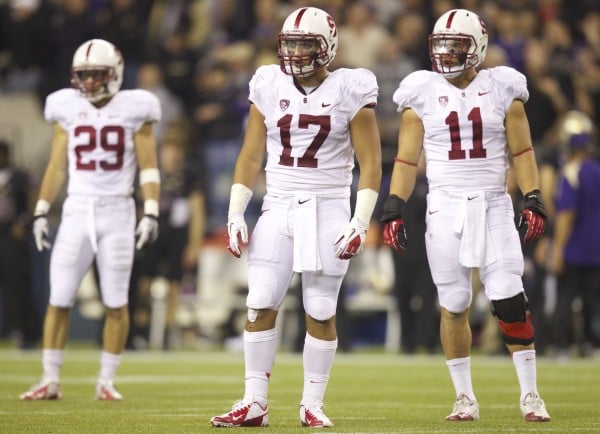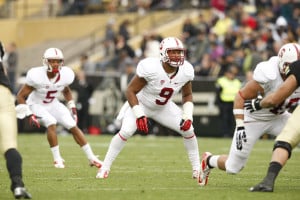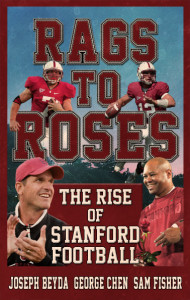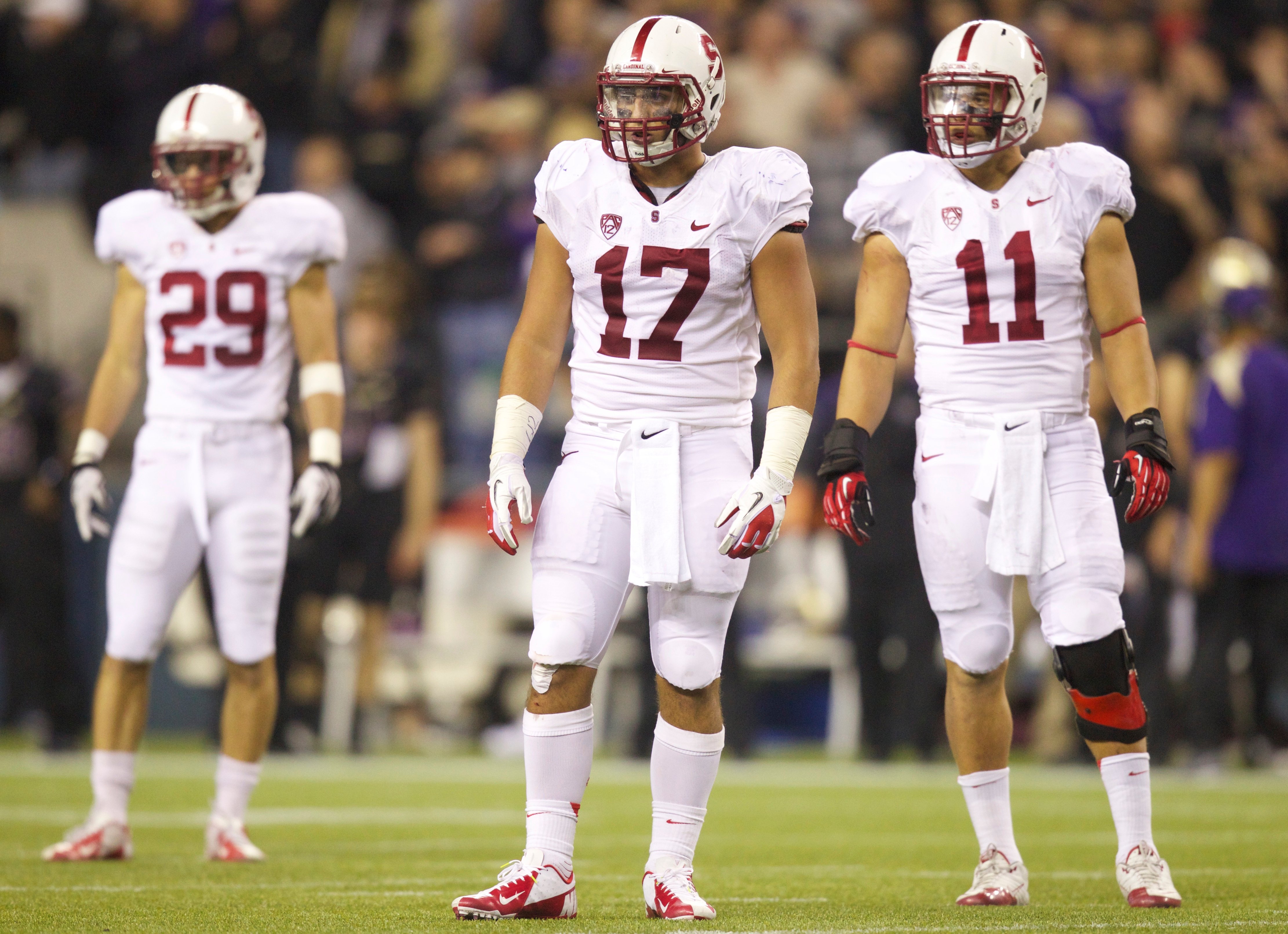Tie game at Autzen Stadium. Oregon has the ball near midfield, threatening to score as always. Stanford has somehow held Oregon to 7 points so far, but there are still 22 seconds left in the first half — plenty of time for the Ducks’ dizzying offense to break the tie.
Redshirt freshman Marcus Mariota, the most efficient quarterback in the country, drops back to pass. The Cardinal brings a three-man rush, giving Mariota enough time to scan the field. The speedy De’Anthony Thomas, running a post, has seemingly found a hole in Stanford’s coverage and sits well in front of safety Ed Reynolds. Mariota steps up in the pocket and then fires a bullet down the field. The pass is accurate and seems destined to hit Thomas right in the chest for a big first down.
Instead, the ball falls into the hands of Stanford junior inside linebacker A.J. Tarpley.
When the play started, Tarpley had drifted towards his left, but as he read Mariota’s eyes, he instinctively cut back to the right side of the field. The inside linebacker was awarded with an interception, dashing Oregon’s hopes of taking a lead into halftime. And the rest, as they say, is history.

After leading the Cardinal’s fearsome linebacker corps with five pass break-ups in 2012, Tarpley returns this season as one of the Pac-12’s premier linebackers in pass coverage. The senior’s playmaking ability, though understated, has shined on the biggest stages.
Tarpley’s interception against Mariota was no fluke, as he also picked off USC’s Matt Barkley and made the game-winning fumble recovery in Stanford’s 56-48 triple-overtime victory over the Trojans two years ago. Late in the 2012 Pac-12 Championship Game, Tarpley also read UCLA quarterback Brett Hundley perfectly on a third-down pass play, but couldn’t hold on to the ball for the interception. Put simply, Tarpley has come up big against the top two quarterbacks in the conference going into this season as well as the scary-good 2011 version of Barkley.
“I would say [Tarpley] and Ed Reynolds have the best feel for the game of football, of guys who we’ve been around since we’ve been here,” said head coach David Shaw, who joined the program in 2007. “As far as reading quarterbacks, reading route schemes, knowing where they’re supposed to be and then making plays on the ball when it’s in flight, it’s uncanny.”
Tarpley noted that he trades tips with Reynolds, who was the team’s renowned ball hawk last season with three pick sixes, about reading the quarterback’s tendencies and receivers’ route schemes. But his communication skills aren’t just useful during film study. Tarpley and partner-in-crime Shayne Skov act as the “middle men” of the defense on game day, as Tarpley relays important information to the secondary and Skov communicates with the line.
“Ed’s a good friend of mine,” Tarpley said. “I’m always communicating with [the secondary]. We want to make sure we’re on the same page…We have to tell them what we call up front and they have to tell us what the coverage is.”
Though Tarpley has drawn praise from his coaches and teammates alike, he was fighting for a starting role just a year ago. Tarpley had won the first-team Mike linebacker spot midway through 2011, but with the depth that Stanford had at the position, his job wasn’t secured until he earned it with impressive in-game performances. The Minnesota native started in 11 of last season’s 14 games and saw significant playing time in the other three.
“[Tarpley is] just so fundamentally and technically sound,” said Lance Anderson, the outside linebackers coach. “His footwork is off the charts. He’s just a real technician in every thing that he does; he does things right and has a great feel for the game. He’s a smart guy and has a great football IQ.”
“Shayne gets all the credit — deservedly so, he’s a phenomenal player — but when you just watch A.J., you say, ‘This guy is an NFL linebacker,” Shaw said. “He does it all and has a great feel for the game of football.”
Though Tarpley’s touted ability to pass cover is rooted in his good instincts, he also credits practicing with the great trio of tight ends that have played for the Cardinal the past two seasons: Coby Fleener, Zach Ertz and Levine Toilolo. Both Fleener and Ertz earned All-America honors, and Toilolo’s 6-foot-8, 260-pound frame certainly provided a formidable test for Tarpley, who stands six inches shorter and 20 pounds lighter.
“I do pride myself on covering,” Tarpley said. “I want to be able to cover [an opponent’s] tight end, the conference’s best tight end. In that game when we play those guys, I want to be the one who says, ‘Hey, I’m going to cover this guy one on one.’”
Tarpley should see plenty of those opportunities this season because the Pac-12 boasts a heap of tight end talent, including Washington’s preseason All-American Austin Seferian-Jenkins and Oregon’s dependable Colt Lyerla. Many of Tarpley’s teammates felt that he was robbed of an All-Pac-12 honor last year, but if the inside linebacker continues to build on his natural pass-cover instincts, he will be the one doing the robbing in 2013.
The eye-blacked man who needs no introduction, fifth-year senior Shayne Skov, will play alongside Tarpley as the Will linebacker. Skov, who was named Walter Camp National Player of the Week for his 10-tackle performance against Oregon, has become the face of 2013 Cardinal team and recently graced the cover of Sports Illustrated. Though Skov lost some of his speed and explosiveness last season as he was recovering from a brutal knee injury suffered in 2011, the fiery leader is, at the very least, back to his old form.
“We really started to see it in that second half of spring practice,” Anderson said. “He really started to look [how] he looked before the knee injury. He’s looked great this fall camp, and looking back at the film from last year, you could tell he still wasn’t 100 percent. Now he’s back to where he was before the injury — maybe even a little better.”
“Just the ability to bend, the ability to play low, the ability to change direction, the ability to accelerate — that stuff is back to where it was before,” Anderson added.
If the deadly combination of Tarpley’s pass coverage skills and Skov’s explosiveness coming off the snap isn’t enough to have opposing offenses quaking in their boots, then the versatility of fifth-year senior linebacker Trent Murphy will certainly finish the job. Nicknamed “The Yeti” by his teammates, Murphy led the Cardinal in both sacks (10.0) and tackles for loss (18.0) last season, benefiting in part from the attention that opposing offenses paid to his partner, current NFL free agent Chase Thomas. The 6-foot-6, 261-pound beast isn’t short of ball-handling skills or speed either, as Murphy intercepted Washington quarterback Keith Price for a pick six in an impressive display of athleticism last season.
What’s scarier is that Murphy could be even better this year.
“Trent has a big ceiling,” Anderson said. “He’s a big, athletic kid with tremendous athletic ability. Moves really well for a kid his size. He missed some sacks last year; he missed some opportunities. He can definitely get better; he’s worked really hard this offseason and we can expect great things from him.”

The remaining linebacker spot in Stanford’s 3-4 defense is the outside slot opposite of Trent Murphy. Senior Blake Leuders and junior James Vaughters, who transitioned from the inside back to the outside this offseason, hope to follow in the big footsteps of Thomas, but redshirt sophomore Kevin Anderson has also asserted himself in the competition.
“[Kevin Anderson is] very good as a pass rusher. That’s his strength right now,” Lance Anderson said. “But he’s getting so much better; he’s a smart football player. He’s getting better playing in space. He’s getting better with his pass drops and pass coverage.”
Before each season, the Stanford players sign a team covenant, which lists the goals, rules and mottos that the players — not the coaches — come up with and will live by throughout the season. With so much depth and talent at the linebacker position, one particular adage on this year’s covenant best sums up the unit’s — and perhaps the team’s — mindset : “We hunt together, but we wait for no one.”
“What that means is we want to do every thing we can possible together as a team and with as many people as we can, but at the same time, we’re past waiting on people,” Tarpley said. “We don’t have time for it, so whoever is with us is with us. Whoever can play full speed to all their ability, they’re with us.”
“But if they can’t, we have to leave them.”
Contact George Chen at gchen15 “at” stanford.edu.
The Daily’s football preview series will be back early next week, as we take a look at Stanford’s defensive line and running backs.
Previous installments in our 2013 football season preview:
Aug. 19: Upstart tight ends look to fill void left by Ertz, Toilolo
Aug. 14: Hogan embraces leadership role, ready to take the next step
Aug. 13: Offensive line powers forward, seeks new center

